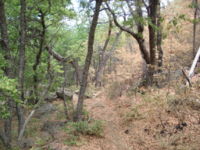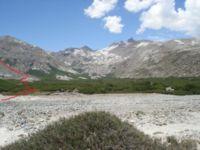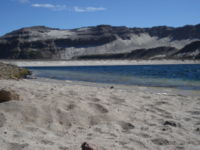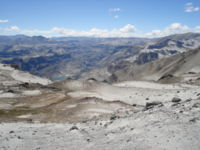Diferencia entre revisiones de «Laguna Mondaca (english)»
| Línea 1: | Línea 1: | ||
| + | {{Google Translation|Laguna Mondaca}} | ||
{{Trekking Chile}} | {{Trekking Chile}} | ||
{{Access Parque Inglés}} | {{Access Parque Inglés}} | ||
Revisión del 18:36 1 nov 2009

|
Contenido
Getting there
By car
Exit the Panamerican Highway (Ruta 5 Sur) to the East, via the town of Molina, then follow the K-175, followed by the unpaved K-275 until you reach the small village of Radal, which is situated 72 km to the southeast of Molina, and serves as the gateway to the national park. You then have to keep following the same road uphill for around another 10 km in order to get the CONAF park rangers' office in Parque Inglés
In order to get to the village of Radal and the national park from Talca, you have to leave the city to the East, passing through the settlements of Lo Beño and La Placeta on the way. The first 30 km of this route are paved. The remaining 40 km consist of travelling along a decent-quality gravel road. The road does get narrow in certain spots but it does have passing places, which you might have to pull into, from time to time, in order to allow oncoming traffic to go past you.
By public transport and hitchhiking
From Santiago, the only bus company that goes directly to Molina is PULLMAN DEL SUR. These buses leave from the "Terminal Alameda"/"Terminal de Santiago" complex , which is located next to the "Universidad de Santiago" Metro station. It isn't possible to buy a return ticket from a Santiago but the price of a one-way ticket should cost CLP $4,000-$5,000
During the peak season -- largely defined, in this case, as from Christmas time to the end of February -- buses go all the way to Parque Inglés from Molina. These local buses leave from the bus terminal, which is located about half a block away from Molina's main square (Plaza de Armas). If you have any enquiries about the buses then e-mail "Buses Hernandez" buseshernandez@gmail.com. Address: Calle Maipú 1735, Molina. Bear in mind that, for about nine and a half months of the year, these buses only go up as far as the village of Radal, which serves as the entrance to the protected area.
A second option is "Buses Radal Siete Tazas", whose buses GENERALLY only run during the months of January and February, and on long public holiday weekends in December.
Both companies have Facebook pages, in Spanish, where they publish their bus timetables
If you miss your bus to the national park and are short of time, you can hitchhike from Valdesina, which is a small settlement on the road between Molina and Radal. You can take a minibus or ("micro") to Valdesina. These minibuses leave from just outside Curicó bus terminal and make a stop at Molina bus terminal on the way. It's just a case of riding one as far beyond Molina as it will take you, and then getting off the minibus before it turns around and heads back the other way. If you can't find a minibus to Valdesina, then just hop on one that has a destination sign on the front that includes the place name "TRES ESQUINAS". These minibuses can at least drop you off on the Molina-Radal road -- specifically, in the settlement of La Palmilla, which is about three kilometres less far up the road than Valdesina. Either way, make it clear to the bus driver that you plan on hitchhiking to Radal/Las Siete Tazas/Parque Inglés, so that he knows where to drop you off.
Bear in mind that if you are visiting the national park, without a vehicle, outside of the peak tourist season, then even in the BEST case scenario, you will have to hitchhike into it from the village of Radal.
Season
It is best to go between October and April, because before that is likely to encounter snow and very cold in the higher sectors of the trek.
Description of the route and suggested itinerary
Day One

It is important to start early, as during the day can become very hot (I recommend going out with about 2 liters of water in the bag, because the next water source will find surely is about 3 hours above ). Before leaving, notify the office of CONAF the route, which serves to receive information about this. The starting point is the CONAF office, going through a gate behind it, through grazing land is being reforested with native forest. After walking about 30 minutes long climb, one passes through an area that burned in January 2008 for a "brilliant" that occurred to him and throw your cigarette smoke.
After a 20 minute walk (always go straight up and not take some of the smaller trails in the area has CONAF) one arrives at a small esplanade. Here is a house built by CONAF observation, a model that will be repeated 40 minutes later on the road in a clearing dominated by a large cypress tree. A few steps away lies a mat in the hottest months is usually dry.
Follow the path that keeps going up, yet surrounded by a forest dominated by ñirres and some cypress. After an hour the landscape start to change, leaving the forest entering an area covered by bushes and the soil is composed of small stones as if an avalanche had happened some years ago. It is in this place that can refill your water bottles. After a few minutes walk definitely opens Indian Valley ñirre covered by scrub, perceiving the Cerro Tres Puntas and Salto del Indio. About 40 minutes later one above CONAF Refuge and Camping El Bolson, where several campsites and a good stream. From this place has a good overview of the Devil Fang. To this place, with fitness and an appropriate load, are about 4 hours. If you left early, I recommend continuing on, otherwise the second day will be very long.
Shelter From the road climbs and passes through a first scrub ñirres sector. In this sector we must be careful because it is easy to lose the route (there are several spray-painted orange arrows pointing toward the river, NOT to follow). Among the options that you can "lose" is delivered directly to the Salto del Indio. After 20 minutes you come out of this first ñirres sector, following the path (in this area is clear) to enter a plain composed of sand and rocks swept away by the river and landslides in the hills north side of the road. About 10 minutes beyond one is empty with a sign, whose information was erased by the sun and snow.
You can see a new ñirres sector, to be taken through the center of it. There is a 'square rock', almost like a table in the middle of a lawn (mowed religiously for horses and cows that roam), with the river right side. From this stone go straight until it touched the wall and follow ñirres left. After a few yards you will find the last miracle in this maze of thick ñirres (I lost myself in this industry when I did this trek). I recommend not taking it on the left side (above the line of the ñirres) or right (by river), why not see where the trail continues, losing the starting point of the hill to the Laguna de las Animas.
After emerging from this thicket of ñirres the road passes through the bed of an estuary, reaching another bush, less dense than the last. From the dry bed of the stream, facing Cerro Tres Puntas, clinging to the hillside which is toward the northeast, will see a sign indicating "Laguna de las Animas". From the sign, should take about 60 to 90 minutes to climb the hill (the path is clear), which has a couple of breaks with good views of the valley. In the saddle, may run a little wind.
The last part of the day is from the saddle, down to the Laguna de las Animas, a remarkable Andean lagoon with white sand beaches that invite a dip stick. To this place, from the Bolson should be 2 to 3 hours depending on the physical condition and accumulated fatigue of the day.Day Two
The trail starts from the south east of the pond, covered up by some sectors in certain seasons of flowers and grass. About 30 to 40 minutes after you leave you will come to a small mat that crosses a large meadow, while at high speed down the slope. After this meadow and one 30 minutes later, they reach the top of a hill, where one stream debiese spotted a wide, but shallow. If you or another should fill their bottles, as when crossing the saddle will not have water for a long time.
From this point, the trail starts to pick up the slope, pointing toward the north. The trail will continue through large fields of volcanic pebble nearly white, a sort of pumice stone, stones stained dark brown. Walk down this pebble can become tiresome (which will be the scene for several hours walk), as one sinks into it and reflects light and solar radiation. It should take about an hour to get to portezuelo, where he will have a unique panorama of Laguna Mondaca and glaciers Peteroa Volcano.Portezuelo fall of always following the hillsides who will be his right side, following the path (the line is noted and in some areas there are small stone monoliths), without suggesting in any way to Laguna Mondaca. The slope in some areas may become pronounced. After about 2 hours to reach a stream, which will seem a piece of paradise in this volcanic desert as the shore is covered with flowers of various colors. Rest in this place and hidrátense.
From here you should go (again with the pleasant volcanic stones) for about 90 to 120 minutes that can become tiring, when finally they headed south to the valley of the Estero del Volcan, which will have a panoramic Descabezado Volcano. From this point is pure descent (in some places rather steep, narrow sections) until you reach a small plain, dominated by a couple of rocks the size of a 3 story house. Hit the estuary, but heading south along the trail. After 10 minutes you can see clouds of steam arising from the hot springs.
The springs are worth all the effort on this day. The floor of the tent will be hot (the mat need not go cold). There are 4 natural pools and putting a worthy one bathroom recomponedor be combined with the icy waters of the estuary. Be careful, as there are 2 that have water at a temperature very high, reaching burn.
Day Three
This day is to get to Laguna Mondaca. Unfortunately due to physical problems with my partner decided not to add the physical burden of another day of walking. What we said other people who were in the bathhouse, is that they were about 7 hours walking among the whole trip, it would have to add the time you're in Laguna. If someone did this part of the trek, supplement.
Day Four
Back on the road to Laguna Las Animas. Leave early to avoid the heat in the field of volcanic stones, while one goes to portezuelo.
Day Five
Same way to English Park. Extremely relaxed, that is pure descent. A good step are as 3 to 4 hours from the lagoon to the office of CONAF. Warn the latest trip to the rangers.
Route
- Day 1: English Park - Laguna Las Animas
- Day 2: Laguna Las Animas - Hot Springs
- Day 3: Hot Springs - Laguna Mondaca - Hot Springs
- Day 4: Hot Springs - Laguna de Las Animas
- Day 5: Laguna de Las Animas - English Park
Waypoints in Google Earth =
Route Waypoints, taken from Schubert and Sieber. To download the file right-click and then select "Save file as" (IE) or "Save link as" (Firefox, Chrome). By trying to open it directly, some browsers will show the raw code with the coordinates.




